Nursing Assignment: Replies to Student Discussions - Nursing Module
VerifiedAdded on 2022/09/13
|6
|1319
|35
Discussion Board Post
AI Summary
This nursing assignment comprises replies to student discussions on various medical topics. The student provides responses to several discussion posts, each addressing a specific medical condition or patient care scenario. The replies delve into aspects such as patient education, ethical considerations like blood transfusions for Jehovah's Witnesses, imaging techniques for diverticulitis diagnosis, and management strategies for conditions like spontaneous abortion, nephrolithiasis, priapism, and testicular torsion. Each reply offers additional information and support from published research, enhancing the discussion with evidence-based insights. The assignment highlights the importance of critical thinking and providing thorough, research-backed responses in nursing practice.
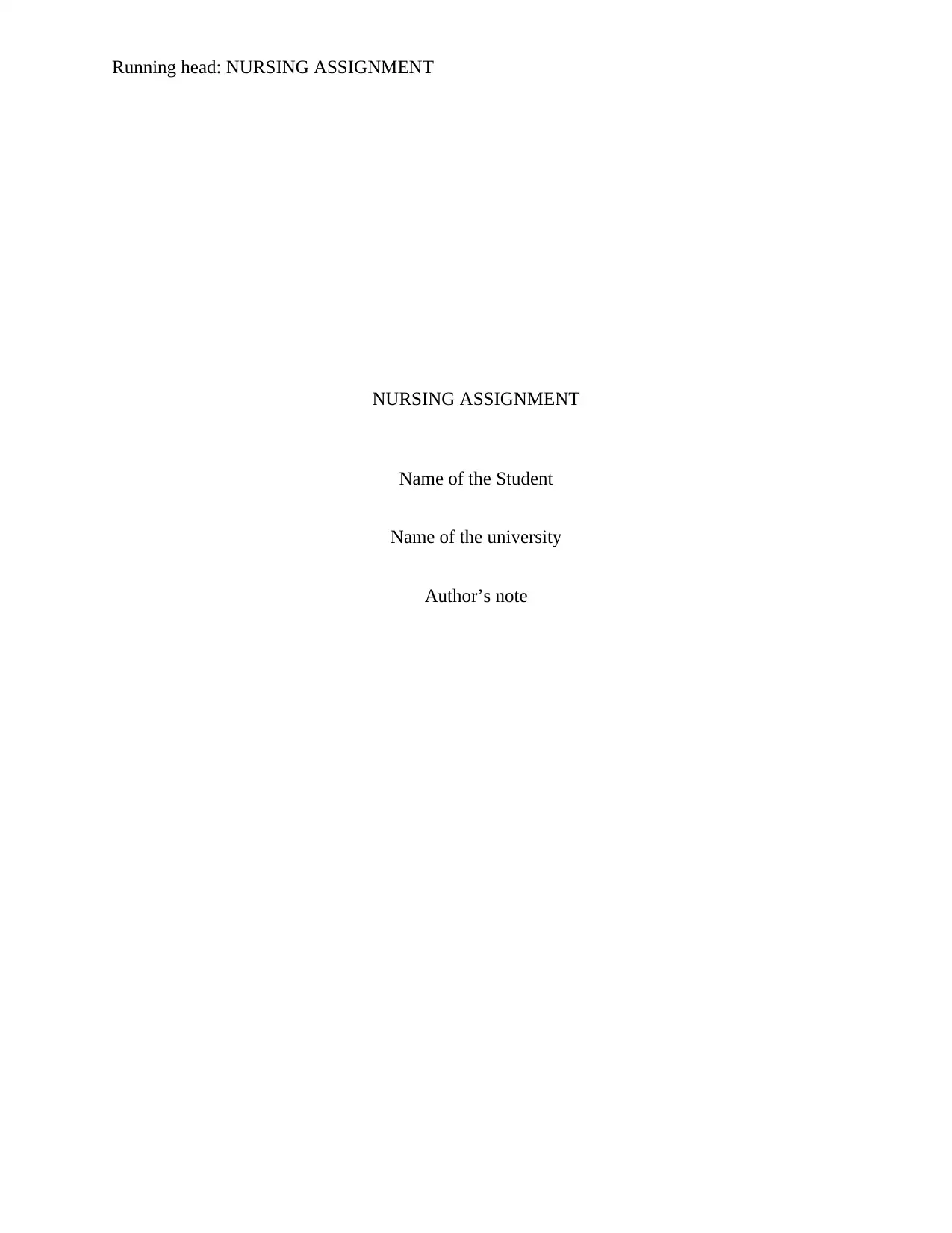
Running head: NURSING ASSIGNMENT
NURSING ASSIGNMENT
Name of the Student
Name of the university
Author’s note
NURSING ASSIGNMENT
Name of the Student
Name of the university
Author’s note
Paraphrase This Document
Need a fresh take? Get an instant paraphrase of this document with our AI Paraphraser
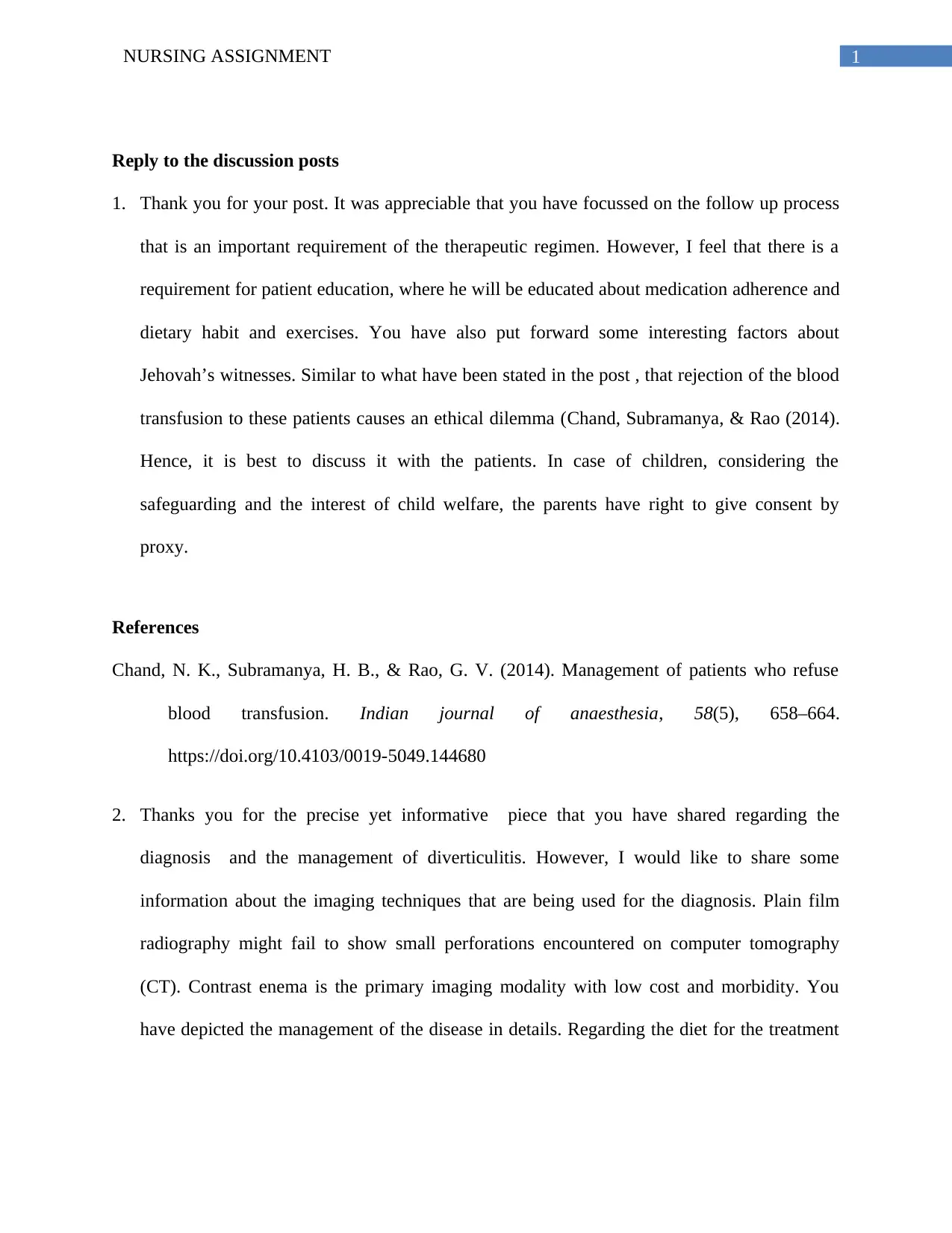
1NURSING ASSIGNMENT
Reply to the discussion posts
1. Thank you for your post. It was appreciable that you have focussed on the follow up process
that is an important requirement of the therapeutic regimen. However, I feel that there is a
requirement for patient education, where he will be educated about medication adherence and
dietary habit and exercises. You have also put forward some interesting factors about
Jehovah’s witnesses. Similar to what have been stated in the post , that rejection of the blood
transfusion to these patients causes an ethical dilemma (Chand, Subramanya, & Rao (2014).
Hence, it is best to discuss it with the patients. In case of children, considering the
safeguarding and the interest of child welfare, the parents have right to give consent by
proxy.
References
Chand, N. K., Subramanya, H. B., & Rao, G. V. (2014). Management of patients who refuse
blood transfusion. Indian journal of anaesthesia, 58(5), 658–664.
https://doi.org/10.4103/0019-5049.144680
2. Thanks you for the precise yet informative piece that you have shared regarding the
diagnosis and the management of diverticulitis. However, I would like to share some
information about the imaging techniques that are being used for the diagnosis. Plain film
radiography might fail to show small perforations encountered on computer tomography
(CT). Contrast enema is the primary imaging modality with low cost and morbidity. You
have depicted the management of the disease in details. Regarding the diet for the treatment
Reply to the discussion posts
1. Thank you for your post. It was appreciable that you have focussed on the follow up process
that is an important requirement of the therapeutic regimen. However, I feel that there is a
requirement for patient education, where he will be educated about medication adherence and
dietary habit and exercises. You have also put forward some interesting factors about
Jehovah’s witnesses. Similar to what have been stated in the post , that rejection of the blood
transfusion to these patients causes an ethical dilemma (Chand, Subramanya, & Rao (2014).
Hence, it is best to discuss it with the patients. In case of children, considering the
safeguarding and the interest of child welfare, the parents have right to give consent by
proxy.
References
Chand, N. K., Subramanya, H. B., & Rao, G. V. (2014). Management of patients who refuse
blood transfusion. Indian journal of anaesthesia, 58(5), 658–664.
https://doi.org/10.4103/0019-5049.144680
2. Thanks you for the precise yet informative piece that you have shared regarding the
diagnosis and the management of diverticulitis. However, I would like to share some
information about the imaging techniques that are being used for the diagnosis. Plain film
radiography might fail to show small perforations encountered on computer tomography
(CT). Contrast enema is the primary imaging modality with low cost and morbidity. You
have depicted the management of the disease in details. Regarding the diet for the treatment
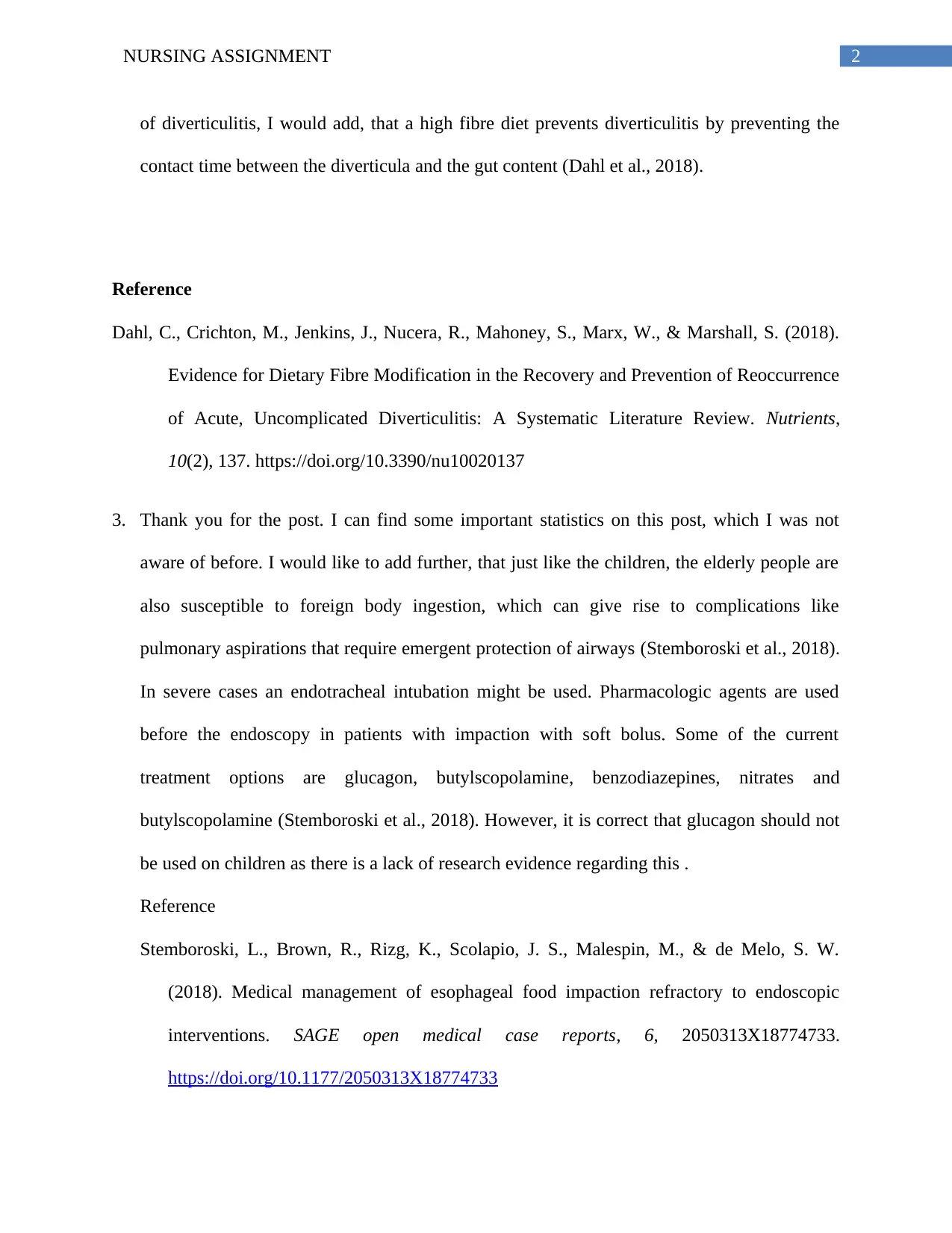
2NURSING ASSIGNMENT
of diverticulitis, I would add, that a high fibre diet prevents diverticulitis by preventing the
contact time between the diverticula and the gut content (Dahl et al., 2018).
Reference
Dahl, C., Crichton, M., Jenkins, J., Nucera, R., Mahoney, S., Marx, W., & Marshall, S. (2018).
Evidence for Dietary Fibre Modification in the Recovery and Prevention of Reoccurrence
of Acute, Uncomplicated Diverticulitis: A Systematic Literature Review. Nutrients,
10(2), 137. https://doi.org/10.3390/nu10020137
3. Thank you for the post. I can find some important statistics on this post, which I was not
aware of before. I would like to add further, that just like the children, the elderly people are
also susceptible to foreign body ingestion, which can give rise to complications like
pulmonary aspirations that require emergent protection of airways (Stemboroski et al., 2018).
In severe cases an endotracheal intubation might be used. Pharmacologic agents are used
before the endoscopy in patients with impaction with soft bolus. Some of the current
treatment options are glucagon, butylscopolamine, benzodiazepines, nitrates and
butylscopolamine (Stemboroski et al., 2018). However, it is correct that glucagon should not
be used on children as there is a lack of research evidence regarding this .
Reference
Stemboroski, L., Brown, R., Rizg, K., Scolapio, J. S., Malespin, M., & de Melo, S. W.
(2018). Medical management of esophageal food impaction refractory to endoscopic
interventions. SAGE open medical case reports, 6, 2050313X18774733.
https://doi.org/10.1177/2050313X18774733
of diverticulitis, I would add, that a high fibre diet prevents diverticulitis by preventing the
contact time between the diverticula and the gut content (Dahl et al., 2018).
Reference
Dahl, C., Crichton, M., Jenkins, J., Nucera, R., Mahoney, S., Marx, W., & Marshall, S. (2018).
Evidence for Dietary Fibre Modification in the Recovery and Prevention of Reoccurrence
of Acute, Uncomplicated Diverticulitis: A Systematic Literature Review. Nutrients,
10(2), 137. https://doi.org/10.3390/nu10020137
3. Thank you for the post. I can find some important statistics on this post, which I was not
aware of before. I would like to add further, that just like the children, the elderly people are
also susceptible to foreign body ingestion, which can give rise to complications like
pulmonary aspirations that require emergent protection of airways (Stemboroski et al., 2018).
In severe cases an endotracheal intubation might be used. Pharmacologic agents are used
before the endoscopy in patients with impaction with soft bolus. Some of the current
treatment options are glucagon, butylscopolamine, benzodiazepines, nitrates and
butylscopolamine (Stemboroski et al., 2018). However, it is correct that glucagon should not
be used on children as there is a lack of research evidence regarding this .
Reference
Stemboroski, L., Brown, R., Rizg, K., Scolapio, J. S., Malespin, M., & de Melo, S. W.
(2018). Medical management of esophageal food impaction refractory to endoscopic
interventions. SAGE open medical case reports, 6, 2050313X18774733.
https://doi.org/10.1177/2050313X18774733
⊘ This is a preview!⊘
Do you want full access?
Subscribe today to unlock all pages.

Trusted by 1+ million students worldwide
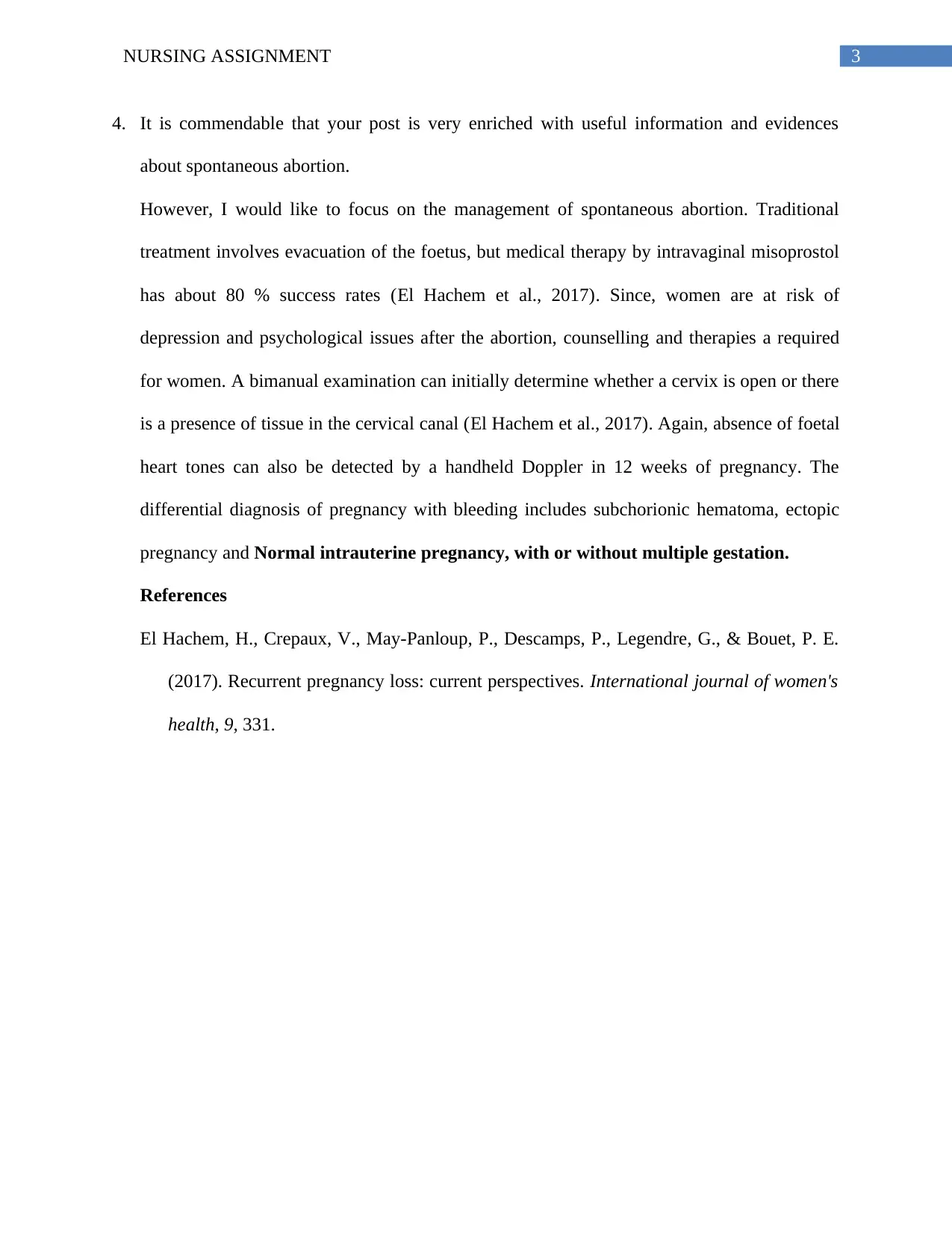
3NURSING ASSIGNMENT
4. It is commendable that your post is very enriched with useful information and evidences
about spontaneous abortion.
However, I would like to focus on the management of spontaneous abortion. Traditional
treatment involves evacuation of the foetus, but medical therapy by intravaginal misoprostol
has about 80 % success rates (El Hachem et al., 2017). Since, women are at risk of
depression and psychological issues after the abortion, counselling and therapies a required
for women. A bimanual examination can initially determine whether a cervix is open or there
is a presence of tissue in the cervical canal (El Hachem et al., 2017). Again, absence of foetal
heart tones can also be detected by a handheld Doppler in 12 weeks of pregnancy. The
differential diagnosis of pregnancy with bleeding includes subchorionic hematoma, ectopic
pregnancy and Normal intrauterine pregnancy, with or without multiple gestation.
References
El Hachem, H., Crepaux, V., May-Panloup, P., Descamps, P., Legendre, G., & Bouet, P. E.
(2017). Recurrent pregnancy loss: current perspectives. International journal of women's
health, 9, 331.
4. It is commendable that your post is very enriched with useful information and evidences
about spontaneous abortion.
However, I would like to focus on the management of spontaneous abortion. Traditional
treatment involves evacuation of the foetus, but medical therapy by intravaginal misoprostol
has about 80 % success rates (El Hachem et al., 2017). Since, women are at risk of
depression and psychological issues after the abortion, counselling and therapies a required
for women. A bimanual examination can initially determine whether a cervix is open or there
is a presence of tissue in the cervical canal (El Hachem et al., 2017). Again, absence of foetal
heart tones can also be detected by a handheld Doppler in 12 weeks of pregnancy. The
differential diagnosis of pregnancy with bleeding includes subchorionic hematoma, ectopic
pregnancy and Normal intrauterine pregnancy, with or without multiple gestation.
References
El Hachem, H., Crepaux, V., May-Panloup, P., Descamps, P., Legendre, G., & Bouet, P. E.
(2017). Recurrent pregnancy loss: current perspectives. International journal of women's
health, 9, 331.
Paraphrase This Document
Need a fresh take? Get an instant paraphrase of this document with our AI Paraphraser
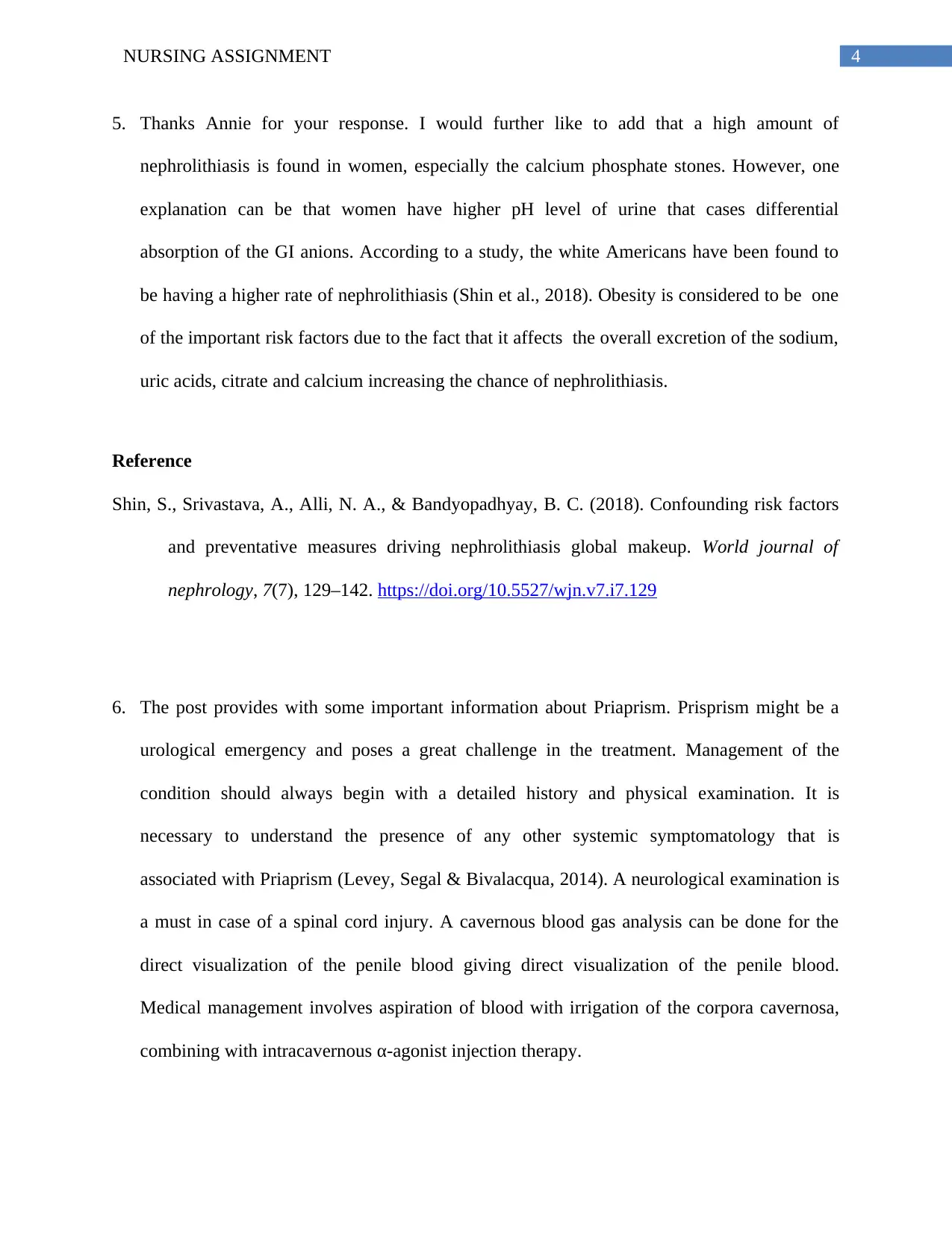
4NURSING ASSIGNMENT
5. Thanks Annie for your response. I would further like to add that a high amount of
nephrolithiasis is found in women, especially the calcium phosphate stones. However, one
explanation can be that women have higher pH level of urine that cases differential
absorption of the GI anions. According to a study, the white Americans have been found to
be having a higher rate of nephrolithiasis (Shin et al., 2018). Obesity is considered to be one
of the important risk factors due to the fact that it affects the overall excretion of the sodium,
uric acids, citrate and calcium increasing the chance of nephrolithiasis.
Reference
Shin, S., Srivastava, A., Alli, N. A., & Bandyopadhyay, B. C. (2018). Confounding risk factors
and preventative measures driving nephrolithiasis global makeup. World journal of
nephrology, 7(7), 129–142. https://doi.org/10.5527/wjn.v7.i7.129
6. The post provides with some important information about Priaprism. Prisprism might be a
urological emergency and poses a great challenge in the treatment. Management of the
condition should always begin with a detailed history and physical examination. It is
necessary to understand the presence of any other systemic symptomatology that is
associated with Priaprism (Levey, Segal & Bivalacqua, 2014). A neurological examination is
a must in case of a spinal cord injury. A cavernous blood gas analysis can be done for the
direct visualization of the penile blood giving direct visualization of the penile blood.
Medical management involves aspiration of blood with irrigation of the corpora cavernosa,
combining with intracavernous α-agonist injection therapy.
5. Thanks Annie for your response. I would further like to add that a high amount of
nephrolithiasis is found in women, especially the calcium phosphate stones. However, one
explanation can be that women have higher pH level of urine that cases differential
absorption of the GI anions. According to a study, the white Americans have been found to
be having a higher rate of nephrolithiasis (Shin et al., 2018). Obesity is considered to be one
of the important risk factors due to the fact that it affects the overall excretion of the sodium,
uric acids, citrate and calcium increasing the chance of nephrolithiasis.
Reference
Shin, S., Srivastava, A., Alli, N. A., & Bandyopadhyay, B. C. (2018). Confounding risk factors
and preventative measures driving nephrolithiasis global makeup. World journal of
nephrology, 7(7), 129–142. https://doi.org/10.5527/wjn.v7.i7.129
6. The post provides with some important information about Priaprism. Prisprism might be a
urological emergency and poses a great challenge in the treatment. Management of the
condition should always begin with a detailed history and physical examination. It is
necessary to understand the presence of any other systemic symptomatology that is
associated with Priaprism (Levey, Segal & Bivalacqua, 2014). A neurological examination is
a must in case of a spinal cord injury. A cavernous blood gas analysis can be done for the
direct visualization of the penile blood giving direct visualization of the penile blood.
Medical management involves aspiration of blood with irrigation of the corpora cavernosa,
combining with intracavernous α-agonist injection therapy.
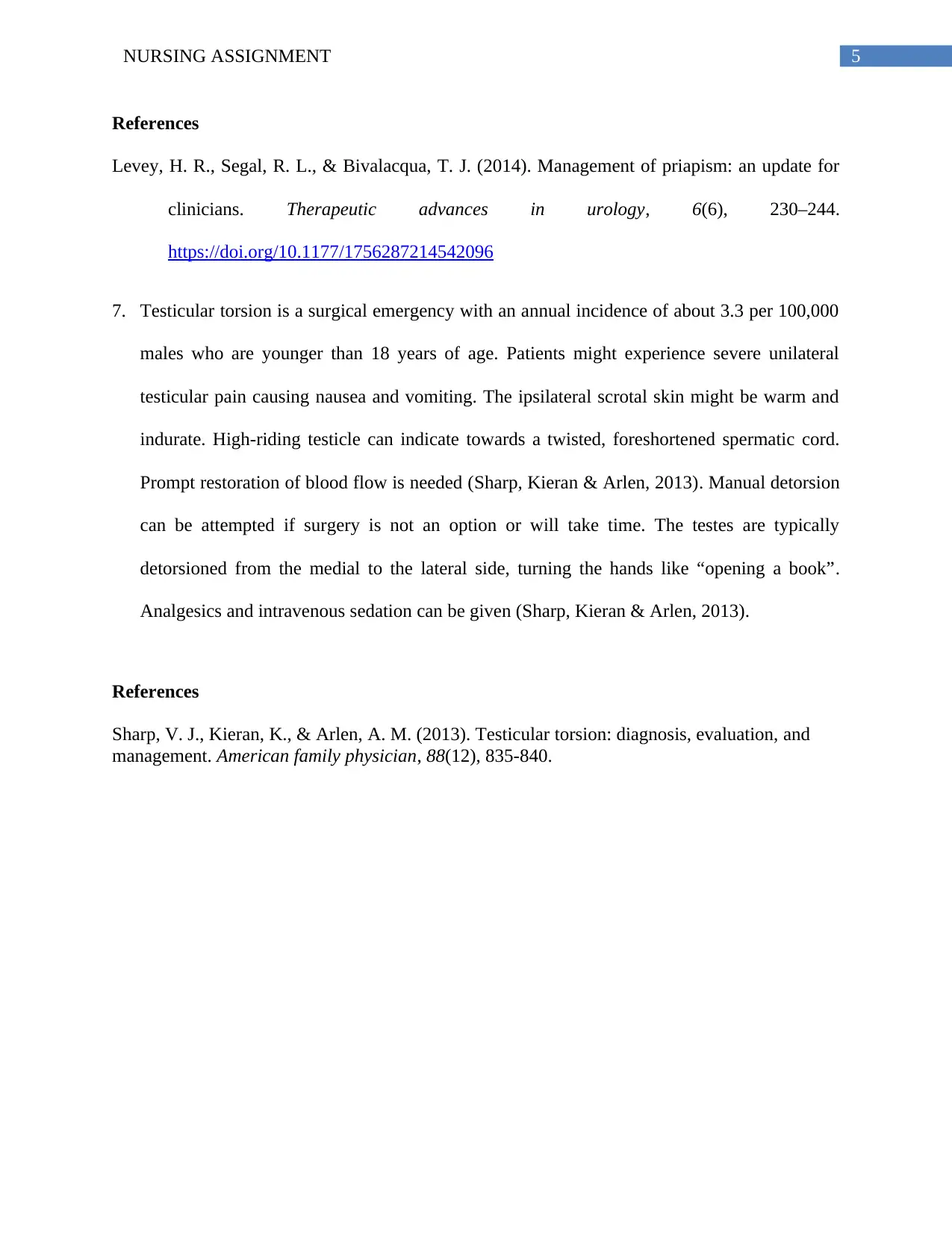
5NURSING ASSIGNMENT
References
Levey, H. R., Segal, R. L., & Bivalacqua, T. J. (2014). Management of priapism: an update for
clinicians. Therapeutic advances in urology, 6(6), 230–244.
https://doi.org/10.1177/1756287214542096
7. Testicular torsion is a surgical emergency with an annual incidence of about 3.3 per 100,000
males who are younger than 18 years of age. Patients might experience severe unilateral
testicular pain causing nausea and vomiting. The ipsilateral scrotal skin might be warm and
indurate. High-riding testicle can indicate towards a twisted, foreshortened spermatic cord.
Prompt restoration of blood flow is needed (Sharp, Kieran & Arlen, 2013). Manual detorsion
can be attempted if surgery is not an option or will take time. The testes are typically
detorsioned from the medial to the lateral side, turning the hands like “opening a book”.
Analgesics and intravenous sedation can be given (Sharp, Kieran & Arlen, 2013).
References
Sharp, V. J., Kieran, K., & Arlen, A. M. (2013). Testicular torsion: diagnosis, evaluation, and
management. American family physician, 88(12), 835-840.
References
Levey, H. R., Segal, R. L., & Bivalacqua, T. J. (2014). Management of priapism: an update for
clinicians. Therapeutic advances in urology, 6(6), 230–244.
https://doi.org/10.1177/1756287214542096
7. Testicular torsion is a surgical emergency with an annual incidence of about 3.3 per 100,000
males who are younger than 18 years of age. Patients might experience severe unilateral
testicular pain causing nausea and vomiting. The ipsilateral scrotal skin might be warm and
indurate. High-riding testicle can indicate towards a twisted, foreshortened spermatic cord.
Prompt restoration of blood flow is needed (Sharp, Kieran & Arlen, 2013). Manual detorsion
can be attempted if surgery is not an option or will take time. The testes are typically
detorsioned from the medial to the lateral side, turning the hands like “opening a book”.
Analgesics and intravenous sedation can be given (Sharp, Kieran & Arlen, 2013).
References
Sharp, V. J., Kieran, K., & Arlen, A. M. (2013). Testicular torsion: diagnosis, evaluation, and
management. American family physician, 88(12), 835-840.
⊘ This is a preview!⊘
Do you want full access?
Subscribe today to unlock all pages.

Trusted by 1+ million students worldwide
1 out of 6
Your All-in-One AI-Powered Toolkit for Academic Success.
+13062052269
info@desklib.com
Available 24*7 on WhatsApp / Email
![[object Object]](/_next/static/media/star-bottom.7253800d.svg)
Unlock your academic potential
Copyright © 2020–2025 A2Z Services. All Rights Reserved. Developed and managed by ZUCOL.